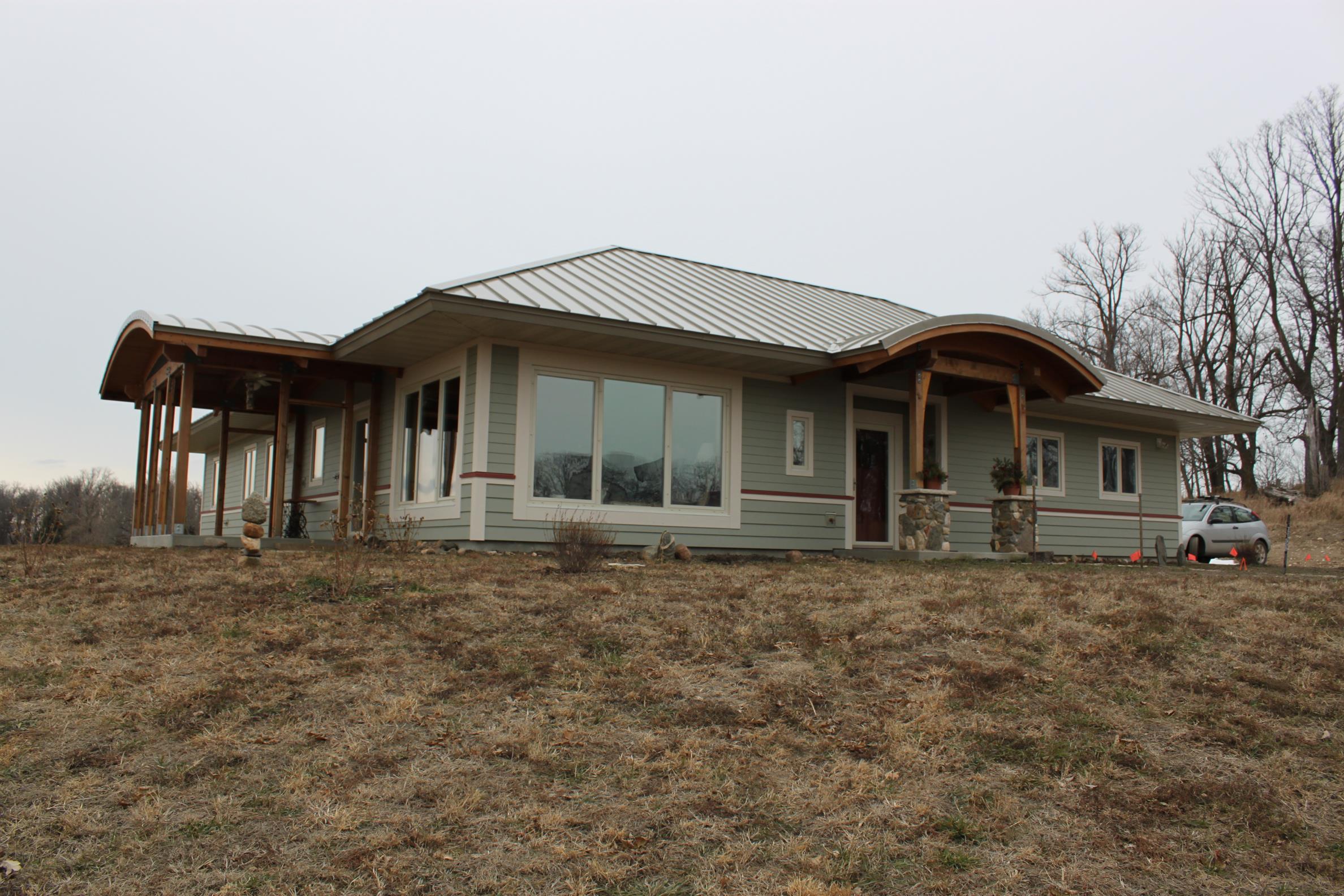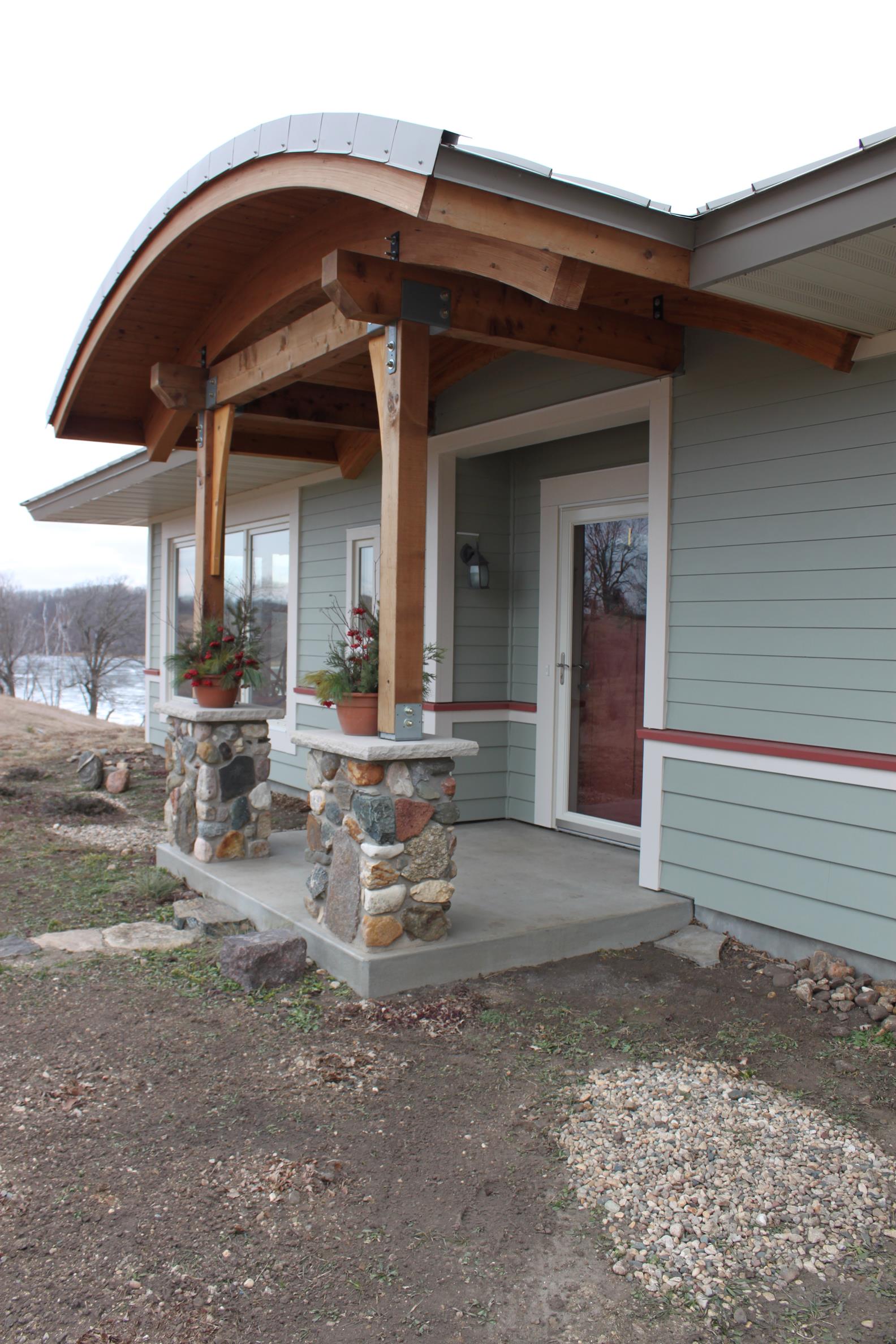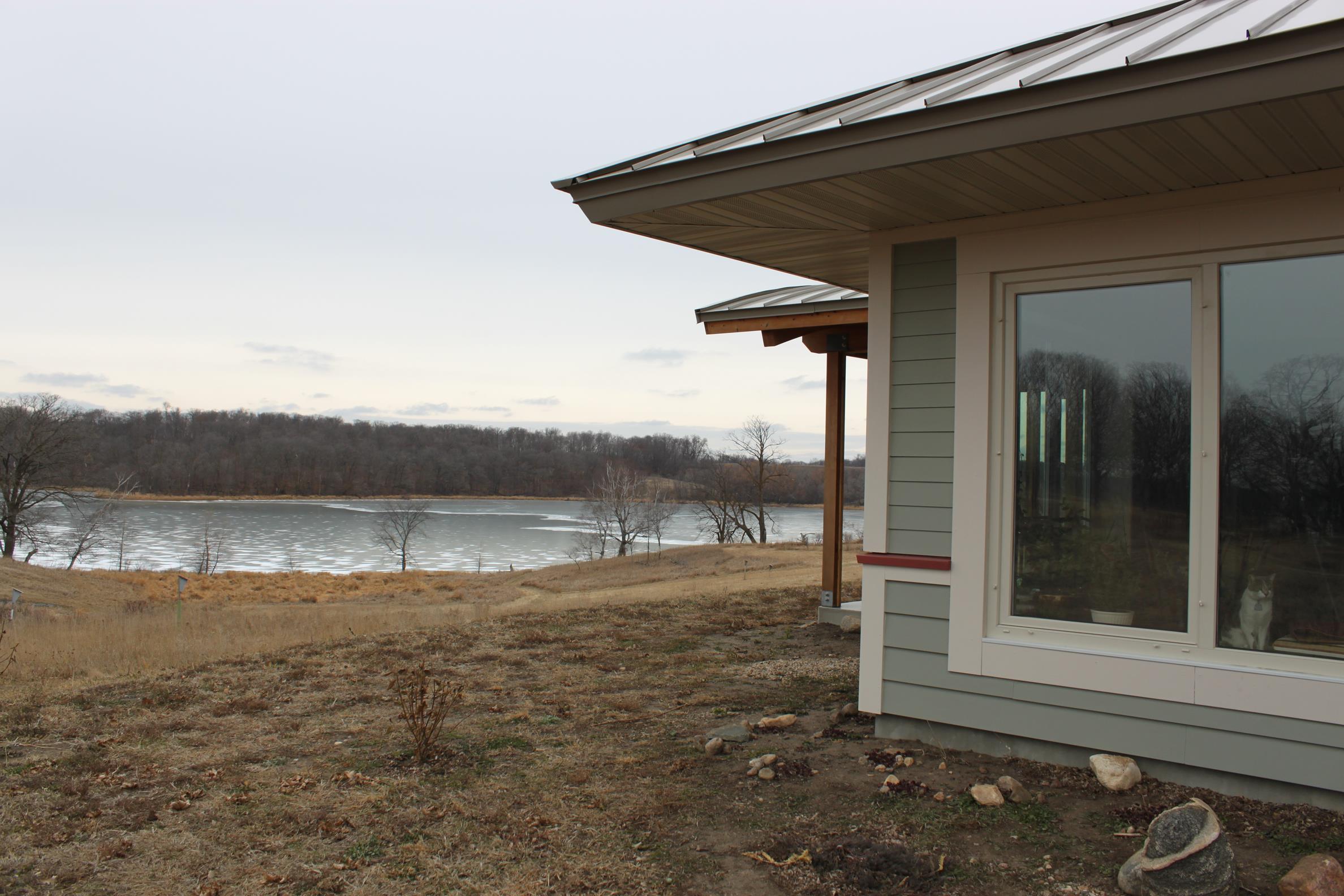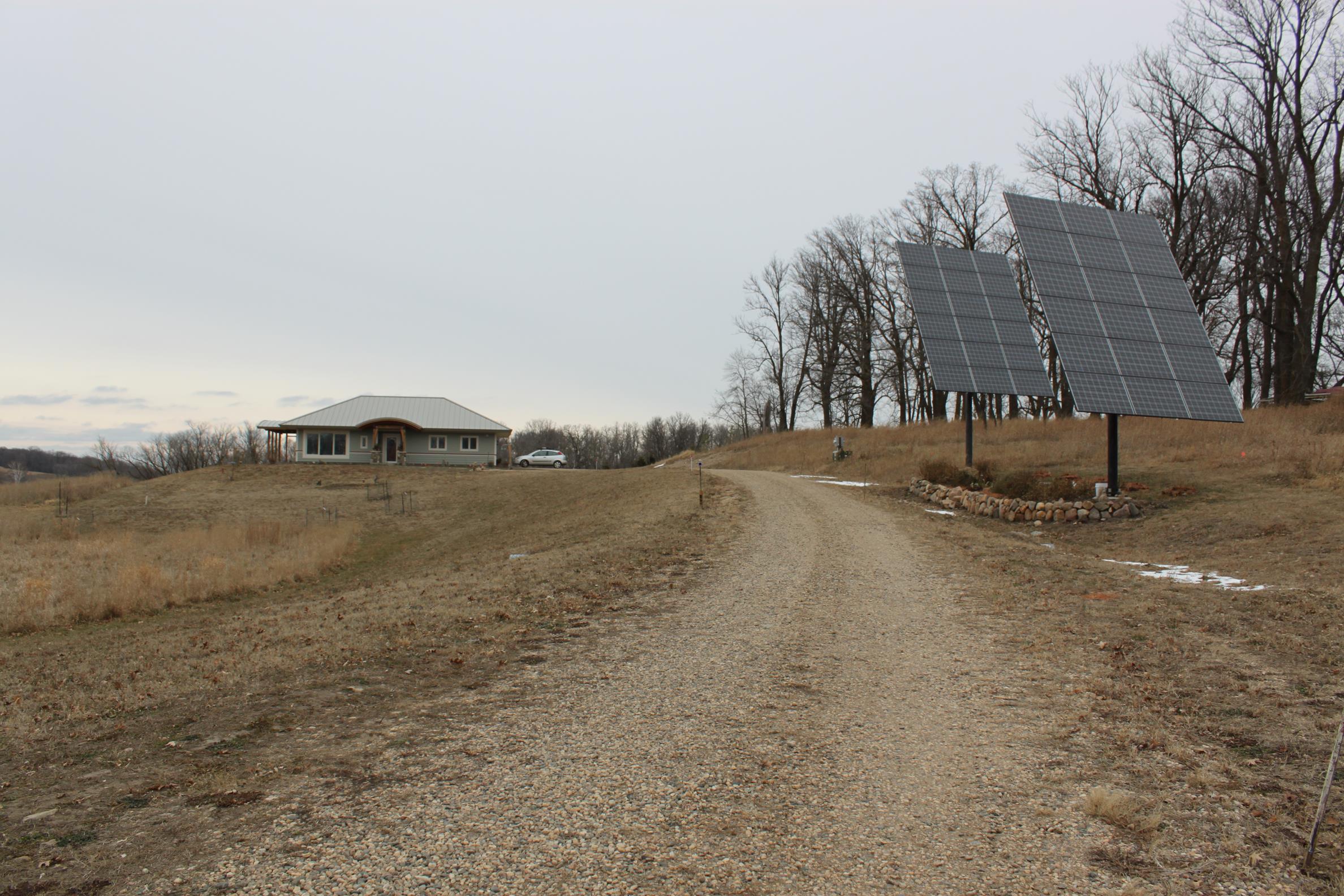Project Description:
The clients, who hired us to design this home on their lake area property, had done their homework. They had a good grasp of what they wanted to acheive, and how they might get there. The goal from the onset was a net-zero home with as much passive solar advantage as they could acheive with a house that would not be ideally oriented. They wanted to be able to "age in place" with mobility friendly features like a curbless shower, and they wanted to make a minimal long-term environmental impact. With an understanding of mechanical system options, and a pre-selected builder who was already delving into high performance building techniques, they brought us on to help turn their ideas into reality.
The Echo Lake Residence is a one-story, slab on grade, two bedroom, two bath home. The home combines 12" double stud exterior wall construction with better-than-average attic and sub-slab insulation, triple-glazed insulated fiberglass windows, a 7.7 KW PV array, and a ground source heat pump. The home was designed to blend well with the open, "prairie-ish" site and take advantage of the westerly lake views while adhering to the "not-so-big-house" principles. The house is simple in form and plan with a little extra architectural exuberance afforded to the entry porch and screened porch.
Building Type Summary:
Address:
Elevation:
Lat. / Long.:
Location Type:
Köppen Climate Type:
Climate Region:
Solar Insolation:
Annual HDD :
Annual CDD:
HDD Base Temp:
CDD Base Temp:
Occupancy Type and Details:
Owner occupied by a retired couple.
Conditioned Floor Area:
Conditioned Building Volume:
Semiconditioned Floor Area:
Multiple buildings?:
Total number of units in project (all buildings):
Total floor area of project (all buildings):
Historic?:
Completion date:
Site description:
This was a hilly lot with a medium sized lake to the south and a small lake to the west. The primary view was to the west.
Materials:
The house is a fairly traditionally built stick-framed structure, only with a high performance envelope. The landscape was to revert to natural grasses after construction for a "no mow" setting.
Energy Highlights:
The house it grid tied with 7.7KW PV array mounted on site atop two poles.There are no trackers on the PV, but the owner alters the tilt twice a year to optimise performance.
HERS Index:
Annual renewable energy generated:
Electric Utility Company:
Electricity amount (imported from grid):
Electricity amount (credited or exported to grid):
Net electricity usage (purchased electricity):
Subslab assembly:
The slab on grade main floor is a 4" concrete slab poured over 8" of XPS insulation (R-40)
Slab edge assembly:
The slab edge is supported by a 6" core ICF stem wall (R-23)
Foundation wall assembly:
The foundation is a 6" core ICF stem wall atop a continuous concrete strip footing.
Above grade wall assembly:
All exterior above grade walls are 11-7/8" double stud walls with 2x4 inner and 2x6 outer studs aligned @ 16" on center. The cavities were filled with dense packed cellulose.
Flat attic assembly:
The attic is insulated with 18" of blown cellulose insulation.
Door Area:
Space heating - Manufacturer & Model:
Space cooling - Manufacturer & Model:
Domestic hot water - Manufacturer & Model:
Domestic hot water - capacity:
Ventilation - Manufacturer & Model:
Process:
This was a pretty standard design process. We worked with the client from the onset of the project to establish the program, assess the site, and establish performance goals. Once the house was under construction, we continued to work with the owner and selected general contractor to revise and refine details where the builder had preferences other than what was drawn and/or specified.
Design for Adaptability:
The house is essentially a clear-spanned box, so interior arrangement of spaces is completely adaptable in the future without having to make significant structural alterations.
Other Software tools:
Autocad was used to generate the construction drawings.
Energy Modeling Software:
REM Rate was used to model the building and estimate design loads.
Outcome of project goals:
I think the house generally met expectations for aesthetics and performance. There were a few glitches though.
The tilt-turn windows were a bit of a disappointment. They preclude putting anything on the nice deep window sills (they were installed as "outies") if you are going to use the in-swing function. Also, there is no restraint capability on that in-swing function, so in effect, if they are open they are "swinging in the breeze".
Also, the owner requested that the attached garage be well insulated and heated to 40 degrees in the winters with a ceiling mounted unit heater. We went so far as to devise a more weather tight overhead door track assembly. As a result, the garage was warm enough to melt the snow off the cars, but the exterior temperature was well below freezing, so the frost build-up on every wall, window, and door surface was substantial.
Discrepancies:
The energy model and the monitored performance of the house were quite similar.
Finances Description:
The final costs for this project stretched the owner's budget, but not past a breaking point. We have seen fairly substantial construction costs in our part of the country, and this was no exception. We didn't get "all in" final construction numbers, but it was in the $225/per square foot ball park for the house construction. It should be noted that this isn't substantially more than standard construction in our region however, and the high performance qualities of the build were not the sole reason for the high construction cost.
Special architectural measures:
An attempt was made to capitalize on the passive solar opportunity presented by the ample southern exposure. Unfortunately, the best views were to the west, which dictated much of the space orientation and glazing locations be west facing. The solar exposure was at least utilized with the pole-mounted PV system.
Energy Strategies:
The owner guessed at the annual energy usage and sized his PV array based on those estimates. Since moving onto the house in 2010, the owner has monitored and reported a small new over-production of electrical energy averaged over the course of each year.
Space conditioning is by a ground source heat pump and a dual fuel arrangement with propane back-up.
Energy Use and Production Documentation:
Subslab R-value:
Slab edge R-value:
Foundation wall R-value:
Above grade wall R-value:
Flat attic R-value:
Average window U-factor:
Solar Heat Gain Coefficient:
Visible Light Transmittance:
Door U-Factor:
Air Changes per hour, ACH50:
Project Photos:





Number of Bathrooms:
Scope Description:
New single family residence with an attached 2-car garage.
Site conditions:
Renewable Energy Sources:
Summary of enclosure strategy/description:
The general approach was to employ "super insulated" walls, attic and sub-slab insulation levels, combined with aggressive attention to air sealing during construction.
Window Description:
The windows are Inline fiberglass, tilt-turn and fixed units with insulated fiberglass frames.The IGU's are tri-pane assemblies with warm edge spacers and various coatings depending on glass orientation.
Door Description:
Exterior doors are insulated fiberglass units. The patio door is a tilt-turn unit to match the window unit's performance and glazing specification. The entry door is an insulated fiberglass unit with dual pane 1/4 lite glass.
Number of Bedrooms:
Team Members:
Architect: Wagner Zaun Architecture, Duluth MN
Builder: Zeltwanger Construction, Hancock MN

Mechanical Equipment Installation Details and Comments:
All mechanicals are within the conditioned space. Energy star lighting.